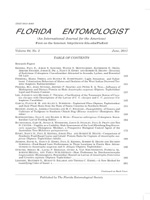Four different types of organic mulches were evaluated for their effects on soil surface insects and related arthropods. Field experiments were conducted in fall 2007 and 2008 near Citra, Florida. In both the years, five treatments were compared: cowpea (Vigna unguiculata (L.) Walp.) mulch, sunn hemp (Crotalaria juncea L.) mulch, sorghum-sudangrass (Sorghum bicolor Moench × S. sudanense ((Piper)] Stapf) mulch, pine bark nuggets, and unmulched control. Data were collected on insects and other arthropods using pitfall traps. Results indicate that organic mulches can affect a wide range of different insects. Diptera, dominated by Asyndetus spp. (Dolichopodidae), were most dense in pine bark plots in both years. Populations of small plant-feeding insects such as Aphididae, Thripidae, and Aleyrodidae were most dense in cowpea and unmulched control plots in one season. It is possible that these insects were affected by weed growth in cowpea and control plots. Ants, which tend or feed on small plant feeders, were fairly abundant in these plots as well, as were predatory beetles. Some groups, such as Collembola (mainly Isotomidae), spiders, and Orthoptera (Acrididae and Gryllidae) were unaffected by mulches.
How to translate text using browser tools
1 June 2011
Effect of Organic Mulches on Soil Surface Insects and Other Arthropods
Harsimran K. Gill,
Robert McSorley,
Marc Branham

Florida Entomologist
Vol. 94 • No. 2
June 2011
Vol. 94 • No. 2
June 2011
cover crop residue
insect community
organic mulch
pine bark




